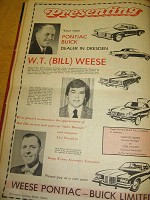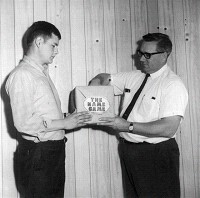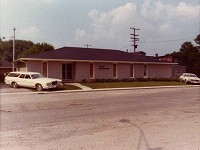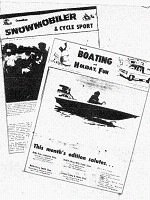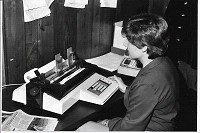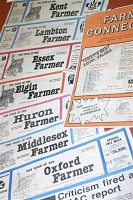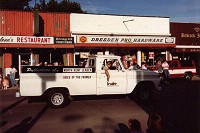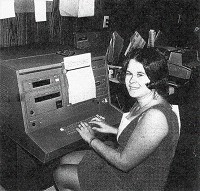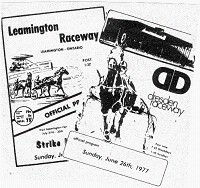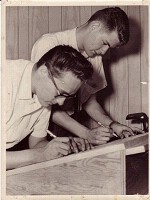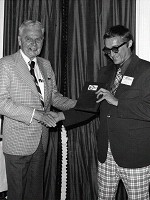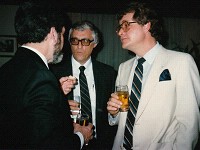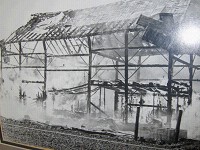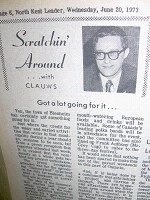The North Kent Leader looks for expansion opportunities as it enters a new decade of publishing growth!
The land for what would become the new home of Leader Publications Limited was acquired in April 1970 from Mrs. Ray McKim. The founding partners and staff would move to the new building in November of 1971. (This segment of the Leader Story covers the five year period of 1970-74.)
The New Home of Leader Publications Limited Was Opened in 1971!
(The North Kent Leader experienced unprecedented advertising growth for Dresden, and the weekly edition was running 24-28 pages on average.)
Follow The Leader
From the founding year in 1965
to the sale of the company in 1988.
This segment presents the years 1970 to 1974.
The year 1970 was indeed an important one in the history of The Leader. Many things transpired that year that established footprints where we had none to follow.
Being very pleased with the first five years of operations for The North Kent Leader, the two partners were becoming anxious and restless by the time the new decade of the 70's rolled around.
It was growing pains, no doubt, that prompted the firm to look for expansion. There was ample equipment in place and undoubtedly underutilized and hence the decision to establish a second publication.
That came in the form of the Wallaceburg Shopper. It would be strictly an advertising medium with no news and would be distributed to every household in the town along with the outlying rural areas. The Post Office was used as the distribution method and by early 1970 the first edition appeared.
To assist in the selling of advertising, the company's first salesperson was brought onto the scene in the person of Pat Cassels. He, along with Misselbrook, spent many hours in the Glasstown calling on merchants and business people.
It was however, somewhat of a struggle as the local businesses preferred to support their hometown Wallaceburg News, rather than an outside publication that carried absolutely no news.
The publication was just marginally profitable as the months passed and the decision was made to cease publication in 1973 and to re-direct those energies into another field...Agri- Newspapers.
It was however, an invaluable opportunity to learn from their mistakes, and the two partners accepted the reality that not every new idea or product would always work out as hope or planned.
About the time the Wallaceburg Shopper was shutting down, a former Windsor Star reporter, Gary O'Flynn made the decision to start a second weekly newspaper for Wallaceburg...The Courier Press. O'Flynn invited the two Dresdenites to join him in establishing that paper. They said no.
In reflecting on that decision, Misselbrook recalls, "we likely should have said yes, but at the time we couldn't imagine how we could possibly partner with the hot tempered and highly emotional O'Flynn". The Courier, of course, went on to be a success story in Wallaceburg and continues today as the dominate weekly newspaper serving that community.
Clauws and Misselbrook pushed forward with new print products and publications to add to their growing cluster of business
(Ted Misselbrook is shown with Mel McKaig of McKaig Furniture and Appliances. McKaig draws the prize winner from one of the many advertisng based features published in The North Kent Leader. )
A NAME CHANGE
WAS IN THE
OFFING
The five year annivesary of the birth of The Leader came around in 1970, and with it the need for some changes.
When the two partners first joined efforts to establish the firm, Clauws was the main shareholder but at that time an agreement was reached between the two that should the endeavour continue and be successful changes would be made in five years time. It was agreed that Misselbrook would be able to purchase the required shares to become a more substantial partner.
A new 2800 square foot Leader building was built in 1971 at the corner of Main and Metcalf Ave.
A MAJOR MOVE
AND COMMITMENT
Rapidly the firm found itself outgrowing the small quarters on St. George Street and it was on April 20th, 1970 that land was acquired at the corner of Main and Metcalfe Avenue. The land was purchased from Mrs. Ray McKim, whose husband had operated a successful seed cleaning business from that location for many years. The purchase price was $2500.00
Many late night sessions were in order for the two partners as they struggled with the plans and concept of a new building. Finally a contract was struck with Beaver Lumber Company to supply the materials and local building contractor Stan Piacek was retained to erect the structure. It should be noted that both Beaver Lumber and Stan Piacek Construction were significant advertising customers with The North Kent Leader, and that fact played a role in the decision to hire them. In wanting to keep as much of the construction needs as local as possible, other local sub-trades were utilized. Gerald Wellman was retained as the electrician and Walter McFadden was called on to look after the plumbing, heating and cooling needs for the building.
By November 1971 the excitement came to a head as the keys for the attractive building were handed to the two partners. The 2800 square foot building would serve its purpose well, but only for a few years before another edition would be required.
Shortly after opening the building a decision was made to move into the retail business in a joint venture with Al Gray Stationary, to sell office supplies. One portion of the building near the front doors was lined with shelving for the supplies which the Wallaceburg firm put on consignment. "Sales were never brisk", Misselbrook recalls, "and the venture was soon put into retirement and the area utilized for more office space. "
Custom Typesetting and Creative Composition Department Established Early in Leader life!
LEADER CUSTOM
TYPESETTING DIVISION
As noted the principal reason for the new building was the lack of sufficient space to produce The Leader and some of the other activities that the firm was finding itself involved with. Those activitites involved a custom typesetting and specialty product line. Produced were a variety of booklets, programs and newspapers for other publishers, including the Bluewater Vacation Guide, Bluewater Circle Drive, Ontario Boating and Holiday Fun and The Canadian Snowmobiler and Cycle Sports.
It was intersting to note how some of those activities came about. Jack Thomson who had been selling subscriptions for The Leader in its early years had decided to move into the publishing business and had purchased the publishing rights to the Bluewater Circle Guide. While not equipped to produce the actual book, The Leader typesetting and layout facilities were retained by Thomson to produce the yearly booklet. That job would continue for more than 10 years before he sold out to another individual.
And, the Canadian Snowmobiler and Cycle Sport publication, along with the Ontario Boating and Holiday Fun were yet another story. The publisher of the publications was Louie Whitsitt, a individual as colorful as any four-page centre-spread in a major magazine.
Whitsitt arrived on the Dresden scene before the birth of the Leader. At that time he was actually working for the Dresden News selling for its then Lambton Farmer, and was known by both Misselbrook and Clauws.
Whitsitt was a character in its truest sense. He had three degrees from a University in California...something he acquired during the more than 25 years he had spent in Jackson State Penitentiary in Michigan. Apprently during his younger years, Whitsitt along with two other accomplices had kidnapped a youngster in Detroit whose body was later found floating in the Detroit River. All three were given life sentences and after serving 25 years, Whitsitt was paroled and deported back to Canada.
He established The Canadian Snowmobiler and Cycle Sports in the early 1970's and continued until the mid 80's. Clauws recalls the "loyal" customer of the past, "Louie was something else. We were never paid for the last publication before we started on the next one, but after hounding by both Ted and myself, he would come across with the money"
"That guy gave us more bad cheques (that he later made good) than probably all the other customers we had put together did, in the same time frame" Clauws says.
But, it was projects such as his and Thomson's that produced two important things for the company, an additional income stream and the fuller utilization of the production equipment.
The late 1960's and early 1970's saw many valueable employees come on board with Leader Publications Limited
(Eldine Bedell of Dresden joined the North Kent Leader in 1970 and would end her career in the late 1980's as Leader Publications Limited, Office Manager.)
MANY VALUED EMPLOYEES
CAME ON BOARD!
The late 1960's and the early 1970's saw many valuable employees come on board.
One such individual was Eldine Bedell of Dresden. A young grandmother at the age 0f 39, Eldine started as a typist and bookeeper in 1970. Eldine continued in the front office activities for many years as office manager until her retirement in the late 1980's. Eldine was married to Len Bedell of Dresden, a long standing union member and part of the Canadian executive of the United Autoworkers Union. It was Len who helped the two partners formulate an "employee booklet" outlining the company's responsibilities and those expected from the employees. After the partners compiled the booklet to what they thought was the best for both parties, it was handed over to Len to peruse. He chopped and added parts that he felt were required and the booklet became the standard for the management of the company. In later years street talk indicated that a national union (we believed it to be the CAW) had Leader in their sites for unionization. "We somewhat reluctantly approached Len Bedell with the rumour" notes Misselbrook.
Bedell pointed out that The Leader employee booklet contained the benefits and language that the UAW would want in a contract. "You will not be bothered by union organizers" Bedell said. "After that meeting with Len, the rumour-mill shut down completely" recalled Clauws.
Another employee who had a long standing career with the company was Joan Martin. Joan's interests were in the composition deparment and she rose to be head of that department in a few short years. a highly dedicated employee, Joan continued with the firm and was still employed after the partners sold in 1988. Joan finally handed in her resignation in the early part of the 1990's to enjoy retirement with her husband Alvah, in the city of Chatham.
Still another long time employee of the company came in the personage of Phil Dunlop.
The year was 1972....the firm had become comfortable in their new building and it was time for expansion.
Times were good in agriculture at that time and the decision was made to dust off the publishing rights of The Kent Farmer.
Dunlop, a recent graduate of St. Clair College, and a former resident of Dresden, applied for a job in the advertising department. His talent was obvious, but the company couldn't justify an extra member on the payroll. It was at that point that the Kent Farmer was revitalized and published under his sales guidance on a monthly basis. The paper was to be named "Voice of the Kent Farmer". And thus began Leader Publications Agri-Newspaper Group.
Along with Dunlop, Gord Hardy was hired as the paper's editor. While Hardy's principal duties were with the farm publication, he also assisted in the reporting duties of The North Kent Leader.
And one other valued employee came aboard during that era. Sharyl Turner. a young recently married Dawn Township girl was hired to look after the circulation department and all the details involved in subscription renewals as well as the blanket distribution of the Kent Farmer. Mrs. Turner, who carried the title "Distribution Controller" was in charge of the final step in newspaper publishing and an important one that completed the efforts of the news room, ad staff, and production people. As the years progressed so did Sharyl's career as she moved to being a valued assistant in helping Misselbrook develop a national advertising program in the Voice of the Farmer Publications.
Also coming to the employ of the company in 1973, was
Marie Debruyn. Besides being a capable compositor for the Agri-Newspapers of the day, she was also an accomplished artist and many of the cartoons which were featured in the various publications came from her pen. Marie worked in the Dresden office for many years before transferring in the 1980's to the Petrolia Advertiser Topic where she was in charge of all production facilities. Marie continued in the employee of The Leader for several years after the partners sold in 1988 and in the early part of the new millennium left to pursue a career as a self-employeed writer and historian.
The Voice of the Farmer franchise would grow to a seven county dynamic starting in 1972!
THE BEGINNING
OF A NEW ERA
The return of the Voice of The Kent Farmer was actually the turning point for what was now known as Leader Publications Limited.
"The time was right" recalled Misselbrook, There was a really strong rural economy and farmers were doing very well."
Right from the start, with its motto "your agri-newspapers with the local touch", the publication struck a chord with advertisers, farm groups and farmers alike.
The local approach was one of the newspaper's main appeal for its readership, Misselbrook said, pointing out at the time there were plenty of farm publications but they mostly focused on national or provincial issues and didn't deal with the local scene.
Indeed the response was so strong that two years later, in 1974, the Kent Farmer moved to being published twice monthly.
From this decision, the power of frequency publishing was discovered by the partners. Within months more than a three fold increase in advertising sales had been recorded. Misselbrook recalled that "agri-advertisers put the Kent Farmer on their advertising schedules because of the yearly twenty six issue run". Farm operators also became avid readers and supporters of the voice publication as a result of the free and frequent issues. The awareness of the strength in frequency publishing would become the template by which The Voice of the Farmer franchise would grow to a seven county dynamic.
The Leader goes to the International Plowing Match in 1973 to promote the Voice of Kent Farmer publication.
(1965 GMC Parade Truck frequently used by Leader Publications at area events)
PROMOTION THE...
NAME OF THE GAME
After the Voice of the Kent Farmer was re-established in 1972, it became necessary to promote the concept to the outside world.
It was decided in September of 1973 that with the annual International Plowing Match being held in the adjoining county of Lambton that a promotional booth be established to introduce the outside world to the concept of local farm publishing.
"It was somewhat of a crude booth, "recalls Clauws, "We used pipes to set the backdrop (which were made by his wife) and a table in front was all we had the first year."
As time progressed, the firm would attend numerous International Plowing Matches as well as the annual spring farm show at London's Western Fair Raceway. "It wasn't long before we knew we had to do something a little more elaborate,"says Missselbrook. The firm, under the watchful eye of Misselbrook , had a professional booth completed a few years hence.
Looking back into the files of the past it is revealed that Leader Publications had such a booth at Plowing Matches in Kent County (1979), Woodstock in Oxford County (1980,) Lucan in Middlesex County (1982) and St. Thomas in Elgin County in 1985.
While one can never measure the exact success of such advertising promotions, there was no doubt that the exposure presented through those exhibitions were invaluable.
"It simply helped to create top of the mind awareness for Leader Publications and the Voice of the Farmer Agri-Newspapers,"claims Misselbrook.
In 1970 Compugraphic Canada introduced the first keyboard-operated system to set headlines and display type and Leader Publications bought one!
(Sharyl Turner is shown operating one of the Compugraphic Canada typesetting machines introduced to Leader's growing bank of equipment.)
CUTTING EDGE
TECHNOLOGY
As time progressed in to the early 70's, the two partners were ever aware of the need to keep up with changing times.
"Actually we started back, in the late 1960's as many rapid changes took place within the publishing world, "recalls Clauws, "Newer, faster equipment was always being introduced and we attempted, for the most part, to keep pace with those changes."
He recalls the first major change after the initial "Stripprinter" was a new headline setting machine that used a "wheel font" to produce neatly spaced headline or display type one character at a time. One had to have a different "wheel font" for each size and for each style of type.
"Looking back it was a primitive method, "says Misselbrook, "But at the time it was the most modern equipment available."
The early 1970's brought many more new and rapid changes to the industry as a firm known as Compugraphic Canada came into being. Actually the firm was established back in the early 1960's but didn't really get into the publishing aspect until almost 10 years later.
In 1969 the firm introduced a 7200 Headliner, the first keyboard-operated machine to set headlines and display type.
"We couldn't wait to get our hands one one of those babies, smiles Clauws, "it was late 1970 before we were able to obtain one due to its popularity, especially among small publishing firms.
Two years later the famed Justowriters that set the text matter for the newspaper and specialty operations were put on a shelf in the back room and branded obsolete as another Compugraphic invention arrived in Dresden. It was the Compuwriter series of machines. The Compuwriter I was the first direct-entry text phototypesetter not using punched paper tape and gave operators a selection of four typefaces, complete keyboard control and complete control of character count. The machine gave much needed day-to-day flexibility to small publishing and print shops.
Things sort of levelled off at that time, at least for a few years, but by the time the back side of the 70's started, Compugraphic was at it again. This time it was the Editwriter 7500. Actually that system made its appearance in 1977 and combined the keyboard and photo unit in one piece of equipment, enabling one job to be typeset while the operator simultaneously keyboarded another. At the time, the Editwriter was the most successful machine ever introduced within the industry. The Mini-Disk Terminal (MDT), a self-contained stand-alone intelligent video terminal disk drive appeared along with the Mini-Disk reader (MDR) which permitted data on the mini-disk to be input into a phototypesetter. Together, these offered an alternative almost unthinkable a few years previous.
And, The Leader managed to keep up with all those changes. As the workload continued to expand by the mid 1970's the firm was well positioned to tackle amost anything...and they did.
A seperate production department was established to produce programs for Dresden Raceway and operated by a staff of area students!
ANOTHER MAJOR
PROJECT TACKLED
The early 1970's also brought another project into the hands of the company. What started out as a relatively small endeavour ended up being a major challenge for the partners as they agreed to produce raceway programs for the then fledgling Dresden Raceway.
Actually, the task of producing the programs came in two parts. The composition and layout was given to The Leader and the actual printing of the program was given to The Observer Press, operated at that time by Don and Betty Spearman. The two firms worked side by side for the first couple of years as a handful of race dates were staged each summer at the race track in south Dresden.
Then things changed. The Raceway was experiencing growing pains and lights were installed around the half-mile oval to allow for night-time racing. First it was a dozen nights a summer..then it doubled and then another year saw the track sponsoring nearly 50 nights of racing a season.
The task of producing programs, often on a four-night a week schedule, became a seperate department within the production department itself, with its own staff of students. Clauws, who was responsible for overseeing the operation recalls that many former students of the Lambton-Kent Composite School became valued employees in that department. Names like Todd Lozon, Lynn Babcock, Sandy Martin and Janice Johnston were but a few of those who passed through the doors of The Leader during those early years.
The production of the programs for the Dresden Raceway continued for several years and by the summer of 1971, the company was also producing a similar program for the twice-weekly races that were staged at the Leamington Raceway.
'The work was intense and the deadlines dreadful, "Clauws recalls, "But the financial returns were fantastic. It was a very important aspect of The Company in its formative years."
Don Sinclair of Bowes Publishers in Wallaceburg was a friend and business systems mentor!
A LITTLE EXTRA
HELP ON THE SIDE
During those early years of the Leader the partners were always looking for new income streams and new methods of conducting business. While the entire workload at the firm was overseen by both partners, they each had their individual departments that took up most of their time. For Misselbrook it was sales/ marketing and credit control for the various publications. For Clauws, it was the news department and production facilities, and the two ususally worked hand in hand when it came to the business office and financial aspects.
With neither partner having any formal training in business accounting, other than the fact that Clauws took "special commercial subjects" in high school, the pair were always looking at new and improved ways to manage the financial side of the business.
"We got a little extra help in that area, "recalls Misselbrook, "We had a mutual friend in the publishing business, Don Sinclair, and his help was invaluable as time passed".
Sinclair was publisher for the neighbouring Wallaceburg News back in the mid 70's. The News was owned at that time by Bowes Publishers...the same firm that owned Webco in London where The Leader had been printed in the early years.
With Bowes being so successful in Western Canada it was evident that they had "company secrets" when it came to publishing profitable newspapers...secrets the owners of the Leader wanted.
On more than one occasion the partners would get together with Sinclair to talk about business in general, but more often to share a late day drink at a local tavern. It was during one of these "sessions" that it was revealed by Sinclair that Bowes had a budgeting formula of revenues and expenses and profit tracking. The partners were interested.
Neither can recall just how Sinclair came to share the information, but the partners got the details and were not long in adapting it to their own operation.
"I recall Sinclair was almost paranoid that we had, in his opinion, coerced the information from him and that if his bosses in London ever found out he was history", says Misselbrook today.
Bowes, of course, either didn't find out or didn't care. Sinclair eventually left Wallaceburg and transfered to other publications owned by Bowes, also in senior management positions. " Sinclair was a talented publisher and a good friend to Leader Publications recalls Misselbrook"
"I will always believe obtaining the Bowes formula from Sinclair was one of the contributing factors to our continued success, says Misselbrook."
Alex "Red" Blackburn was The North Kent Leader circulation manager and "super salesman".
A GROWING
CONCERN
As was noted a few pages back. Alex (Red) Blackburn came on board in 1970 as the circulation manager. A super salesman who simply won't take "no" for an answer, Blackburn was a major boost to the company as he increased paid circulation.
In the September 14, 1972 edition (just seven years after the
founding of the newspaper company) the publishers proudly ran an advertisement proclaiming an 18% circulation increase in the last six months.
"We're far from modest when it comes to saying that we provide the best possible newspaper for the Dresden---Thamesville area. As a matter of fact, we have several Ontario Weekly Newspaper Association awards to back up that statement.
One man who has really helped to get that point across has been our Circulation Manager, Alex (Red) Blackburn.
Alex has done a simply fantastic job with circulation in the last 6 months and he's shown a net paid circulation increase of 18% and we think that is just great.
Don't be a bit surprised (especially if you're not presently a subscriber to The Leader) to see Alex calling on you in the very near future.
While on the topic of subscriptions, it is interesting to note that when the North Kent Leader was established in 1965 the cost of a subscription was $5.00 a year and single copies were 10 cents.
The first change to that price package came in August 1971 when the publishers announced that the cost of a single copy would rise to 15 cents but that subscriptions would remain at the $5.00 for the year.
By March of 1974 the need for a price increase was again necessary and the single copy price rose to 20 cents while a yearly subscription move to $7.00.
A NEW AVENUE OF REVENUE
As the business continued to grow, the partners were always looking for new sources of revenue, or, in some cases, new ways to cut costs.
In January of 1972 the cost of postage was on the increase as were all other expenses and it was decided to make a change in the classified advertising department. That section of the paper was an important one...it was well read, and an important source of revenue.
However, the cost of a classified ad at that time was 60 cents, based on a normal minimum of 20 words or less. Not wanting to actually increase the cost of an individual classified ad, it was decided that a "special bookkeeping fee" would be added if the advertisement was not paid in advance or within one week of the insertion date.
In making the announcement of the changes in the January 6, 1972 edition, the announcement read "It is the sincere wish of the Publishers, that classified users will follow the new procedure so that the present low want ad rates may be maintained."
The practice worked and while the revenue increased very little, the costs of invoicing was greatly reduced.
THE INTRODUCTION OF A NEW FEATURE
While always keenly interested in providing the best source for news possible for the commuinity the partners were forever looking for new features or angles for better news coverage and information.
One such project presented itself in the summer of 1972 with the introduction of "The Enquiring Reporter". Pat Cassels who had been retained to sell advertising for the rather short-lived Wallaceburg Shopper spent a few hours a week being "The Enquiring Reporter". He would hit the streets with camera in hand and randomly pick local residents (and sometimes out-of-towners) to ask the question of the week and seek a photo of that person.
"It was an immensely popular feature" recalls Clauws, "Response from our readers was tremendous and we kept the feature going for several years, although as time progressed we did move it to a monthly presentation."
The North Kent Leader wins best all-round newsaper awards from Canadian Community Newspaper Association!
(Gord Clauws is shown in this 1975 photo along with the Rt. Hon. John G. Diefenbaker. Clauws accepted the award for Best All Round Weekly Newspaper in Canada in our circulation class. It was the 3rd consecutive year that The Leader won this prestigious award. Former Prime Minister Diefenbaker presented the awards during the 1975 CCNA convention held in Saskatoon.)
AWARDS, AWARDS
AND MORE AWARDS
With the company joining the Ontario Community Newspaper Association in the late 1960's, competitions became available to pit newspapers of equal size against one another. While it was a contest, it was just as much an opportunity to attempt to bring home the trophies and the chance to "brag a bit".
The North Kent Leader, competing in the 2,500 to 3,000 circulation class, started entering these competitions by the early 1970's. It should be pointed out that at that time, the Canadian Community Newspaper Association (CCNA) was actually a federation with six provincial or regional members, the Ontario Community Newspaper Association (OCNA) being one member. As such the opportunity was there to compete at both levels, provincially and federally.
The Leader was successful from almost the first entry submitted.
"While we didn't always win first place, we had our share of plaques and blue ribbons and the awards came for everything from top sales ideas to best news stories to best all-round newspaper in our circulation category, "Clauws recalls.
"Actually our first major win came in 1974 when The North Kent Leader was named 'Best All Round Newspaper in Canada' in the 2,500 to 3,999 circulation class." Misselbrook recalls, "it was a time for celebration."
During those and subsequent years, two of the walls in the front office were laden with the many, many achievements that the newspaper accomplished.
"While those awards never brought much money into the cash box. "smiled Clauws, "It always made you proud to bring home some additonal hardware and certificates to hang of the office wall."
ANOTHER MAJOR MOVE TOWARDS THE FUTURE
Before the half way mark of the 70's was reached, with the Main Street building only two and half years old, the partners could see that while the new structure was serving its intended purpose if an addition was ever needed, more land would also be required.
When they purchased the land for the original building in 1971, the back half of the property, facing onto Queen Street, was also vacant but was owned by barber Harold (Dutch) Ellis of Dresden. Apparently Ellis was a great friend of Ray McKim who had owned the lot The Leader had purchased and had promised the adjacent lot to Ellis upon his death. Ray's widow, Vera McKim, abided with her husband's wishes and sold the property to Ellis in 1971.
On March 14, 1974, an agreement to purchse that lot was signed by Harold Ellis and the two partners for a sum of $3,000.
The stage was set for the future.
Clawbrook Holdings was established to manage the real estate holdings.
Another major development to occur before the calendar flipped over to 1975 was the restructuring of the entire company.
Originally set up as a limited partnership between the two founders, their accountant, John Laken, was making strong suggestions that it was time to for a limited corporation.
The decision was made and the corporation became known as Leader Publications Limited. This was completed in August, 1974 and saw the shares of the corporation split between the Clauws and Misselbrook families.
A few months prior to that move, however, another recommendation from their accountant was acted upon. The partnership owned the physical properties at that time, which consisted only of the Main Street building, and it was decided to separate the real estate holdings from the newspaper assets. Hence on March 31, 1974, a separate limited partnership was established to become known as Clawbrook Holdings.
An Interesting side note from Leader Partner Gord Clauws!
THE CHRISTMAS
MORNING FIRE
OF 1974 IN TUPPERVILLE
Of little importance in recording the actual history of The Leader, the following episode was indeed a heart-throbbing one for one of the partners.
It was Christmas morning, 1974. The telephone rang at the Clauws residence with a tip that a house fire on the north riverroad, east of Tupperville, was on fire and it was believed that someone inside had perished.
With camera bag at the ready, Clauws jumped into the company's newest acquisition, a 1975 full size white Ford Station Wagon, with the Leader logo on the doors and "Follow The Leader" prominently displayed at the rear of the vehicle. The new car had been purchased from Duff Motor Sales in Dresden only weeks prior.
The road conditions were not good and as Clauws recalls, "we had a fair bit of snow the few days before Christmas and while the highways were bare and in good condition, the same could not be said about the gravelled country roads." As he headed out 78 highway in a westerly direction he hadn't gone far before he noticed smoke in the distance. He arrived at the concession road just past the blaze and turned towards the river.
Driving, it is to be presumed, faster than he should have he was soon approaching the T-intersection which was the end of the road. Just beyond was the Sydenham River. He recalls he started to slow down and hit the brakes, but knew in a second that he was not going to be able to get slowed down enough to make the 90 degree turn onto the river road.
Clauws recalls he felt sure that the ice on the river would be thick enough to hold the car, but was not absolutely sure and so made a quick decision. Just to the right of the centre of the far side of the river road was a hydro pole. By this time he was probably within a 100 feet of interesection and knew that he was not going to get stopped.
He stopped.
Got out and looked at the car and hydro pole. The front end of the car was badly smashed and the hydro pole split in half with wires dangling in mid-air. Knowing the car wasn't driveable, he grabbed the camera bag and headed down the road on foot. The farm house was only a few hundred yards down the river road and upon arriving, out of breath, was told by the firemen from the Tupperville fire station that they believed a woman was trapped in the house.
Still smoldering, the ruins were photographed and information gleaned from Tupperville firemen and Ontario Provincial Police who were also on the scene.
Clauws recalls he approached the OPP officer at the scene and related details of his car accident. The officer said he didn't have time to get any details and would call later. He was asked to call a tow truck.
"By the time I got back to the car to await the tow truck, a crew from Ontario Hydro was coming down the road, "Clauws says today, "They managed to get stopped."
After surveying the damage the Hydro crew said that the power was off between Wallaceburg and Dresden substations. They apparently said they had to wait for other equipment to arrive because another pole would have to be put in place before restringing the lines and restoring power to the area.
The tow truck soon arrived and driver/owner Glen Henderson had few comments other than to say that he was sure there would be a whole bunch of angry folks in the area since they would have no electrical power until later Christmas Day. Clauws said he felt bad about all the problems, including the fact that the company station wagon was less than six weeks old.
The partner recalled that he did include some of the happenings of his accident in the story and photos of the fire where the owner of the house had indeed perished, but didn't get any phone calls from residents in that area blasting him for disrupting their Christmas of 1974.
"Scratchin' Around with Clauws" was presented with a blend of humour and controvery!
A COUPLE OF
INTERESTING COLUMNS
As noted earlier, Clauws was a regular contributor to the news pages of The Leader through his column "Scratchin' Around With Clauws". The columns were often controversial and at other times humorous, and then some were simply an opinion from a publishers point of view.
There were a couple of columns published in the time frame 1970-1974 that are passed along here for interest.
Dateline: December 31, 1970
Why editors turn gray...
The festive season with all the eats and drinks, as well as the customary exchange of gifts, undoubtedly was a happy and joyful occasion for many people.
It started out that way for this writer, until one of those distant relatives came out with the comments, "getting a little grey around the temples wouldn't you say?" Trying to pass the comment off lightly, I made some snarky remark, but after awhile got to thinking about it. Grey around the temples at this tender age.
The very statement brought to memory a recent article read in one of the rural weeklies published in northern Ontario. After a diligent search we came up with the article and pass it along for your consideration.
Why Editors Turn Gray!
Being the editor of a country newspaper is not the most desirable job in the world---unless you are a glutton for punishment. It is confining beyond what is reasonably accepted these days.
There are constant pressures. That means daily deadlines and everything has to be done in a hurry. As for financial reward, only a few really make it and we seldom advise youth to enter the field unless they are really dedicated and can cope with inherent perlexities.
This does not mean that the newspaper business is completely unrewarding, because there is certain satisfaction in doing any job well.
There is humour in the work and something pops up almost every day that it is good for a laugh. A lot of it comes from the fact that most people feel strongly, one way or the other, about having their names in the newspaper.
Here are a few typical examples, not all original of a number of way to spoil an editor's day.
"
Please put it on the front page."
"Use the story just as I have written it. The club wants it that way for the scrap book".
"You're invited to our annual dinner tonight (this was the third invitation this week and we wanted a night at home.) There will be plenty of free eats and drinks. Oh yes, please bring your camera".
"How come it wasn't in the paper? It was--well I didn't see it. Will you please go through your back issues and tear it out for me."
"I just stopped by for a few minutes, but if your busy.''
"We voted to make you our club publicity chairman."
"I know you have a deadline, but couldn't you just squeeze this little item in?"
"My husband has never been in trouble before so I don't think his name should appear in the paper for drunk driving and hitting that nasty policeman (who was only trying to arrest the man without hurting him). Besides, he only had a couple of beers (the drunkometer showed him nearly dead drunk). And there are the children to think about (he didn't and facts are he regularly gets drunk in front of them and beats the old lady about every Saturday night.)"
"I know it's on Sunday, but it's our annual reunion and someone ought to cover it
."
"My uncle's brother is one of your biggest advertisers and I was wondering if..."
"I'll try to get my ad in to you before the deadline next time."
"You ran the disaster picture, but you didn't get my first wedding anniversary picture until a week later."
" If there wasn't room for the picture, why couldn't they run it on another page."
And there was this column which appeared on October 24, 1973 after the two partners spent a relaxing weekend in "hogtown"...Toronto. Heading to Toronto for a "get-away weekend" was something the two partners and their wives enjoyed and was made much easier through an agreement with the then Lord Simcoe Hotel which provided free accomodations in exchange for advertising space.
The column went like this:
People...they come in all shapes, sizes and descriptions, and sometimes it is interesting to just sit back and watch the various reactions of people as they go about their daily tasks.
Such was the case for this writer last weekend, when a visit to metropolitan Toronto was enjoyed. I say "enjoyed", because it is always enjoyable to visit the larger cities, but at the same time it is even more enjoyable to get back to the old home town.
The rapid pace at which the city moves has not changed. People everywhere are in a hurry, and the line-ups for everything from waiting for food in a cafeteria to purchasing a bag of peanuts from a street vendor at the corner of Yonge and Dundas Streets is evident.
But, sit back for an hour and observe these people as they hurry and scurry along Yonge Street, and you can't get any cheaper entertainment. Such was the case for this writer and co-publisher of the Leader, Ted Misselbrook.
Walking along Yonge Street for a good vantage point as an observation post, we came across a small and unique restaurant with a booth facing Yong Street. The restaurant was unique in that it laid claim to the fact that we serve more steaks that any other restaurant in Toronto"...whether that statement
is true advertising we're not about to say, but the traffic in the restaurant was surprising.
From our vantage point we had an excellent view of a portion of Yonge Street. Among the first observations were the stores across the street...a Toronto-Dominion Bank; The Burgandy Steakhouse and Tavern; African Modern, a store that appeared to feature artifacts from the dark continent; and above it Sultan's Retreat where patrons, it appeared, had a choice of a topless shampoo and sauna, needle-point shower, along with imported figure models, for the photographic nut.
As we watched the city people hurry by, one could not help but notice the various dress that was being worn. While the temperatures dictated to these observers that at least a fall jacket we required, many other people were not of the same opinion. Especially when one man walks by in a T-shirt and cut off denims (but at the speed he was walking he shouldn't get cold). And, behind him came another gentlemen wearing a full length, heavy leather coat (it was evident that this man had problems as he was carrying on what appeared to be a heated discussion with himself.
Ah, some activity across the street. And a young lad dressed in what looked like a costume from some religious sect was having difficulty getting by-passers to take copies of literature he was handing out. With only a pony-tail hanging from his otherwise shaven head, the young man did not seem overly disturbed by the fact that many people were only interested in getting to their destination and had no time to take his free literature.
And what have we here...as another young man dressed in what looked like a U.S. army jacket, complete with blue denims was peeking in the restaurant window, the same window at which we were seated. It appeared that he was either on a cross-country journey, or was simply on his way out of the country, since he was ladened down with a duffle bag over one shoulder and a suitcase in another.
And the women. They came in all sizes and shapes. There were the well-dressed as they strolled by apparently on an afternoon shopping trip, and then there were the others...the bra-less, the breastless and the breath-taking, all appearing to have a destination that they must reach, and the pace they were moving, it was evident they were late.
After sitting for more than an hour observing the by-passers, we decided to head for the street. It was even more interesting walking down Yonge Street. Onto the subway (and at four o'clock on a Saturday afternoon, I would rather be any place than on a crowded subway) as thousands of people push and ram their way through the turnstiles to the underground transportation system.
Finally, arrived back at the hotel for a peaceful rest. And the scene did not change. It happened that weekend we chose to visit Toronto was the same weekend for the home-coming at the University of Toronto, and our hotel was apparently the headquarters for the visiting students from Queen's University at Kingston (Queens and U of T football squads were having a head-to-head battle, on Saturday afternoon). As we stepped off the elevator on the seventh floor, one university student in kilties was heading towards the elevator with a "50" in hand. Apparently unconcerned with our presence, it appeared that he was not where he was supposed to be...but he showed no concern.
And, night-time in Toronto is even more of what this writer would describe as a "rat-race". Take a stroll down Yonge Street on a Saturday night. After a couple of blocks of pushing and side-stepping, you can't wait to find a taxi to get out of the area (we tried the subway and simply turned around when we saw twice as many people fighting to get through the turnstiles than in the afternoon).
Returning home on Sunday, we all agreed that we didn't have what it takes to live in the "big city"....the pace is simply to fast.
We'll take the small town any day, where you can stop and chat with someone you know as you stroll along the sidewalk, without fear of being trampled.
MORE ADDITIONS TO THE PARTNER'S FAMILIES
Before we leave this segment of the History of Leader Publications it must be mentioned that additions to the two founding member's families were welcomed.
Gord and Marilyn Clauws saw the birth of their second son, Darren James, on July 1, 1970 while Ted and Pat Misselbrook welcomed a second daughter, Beth Ann, into the world on December 2, 1972.

